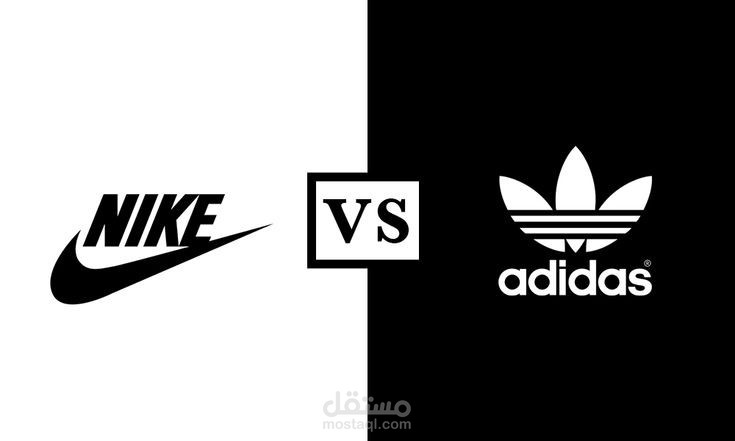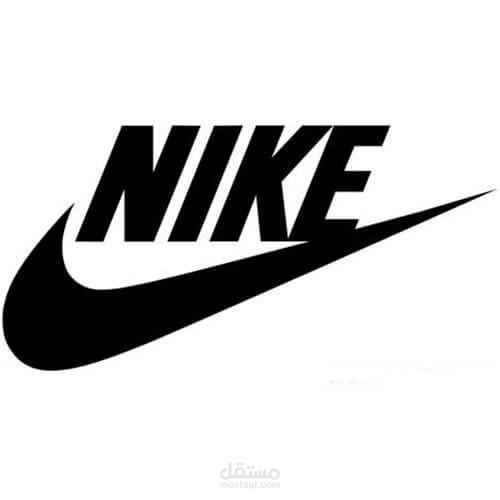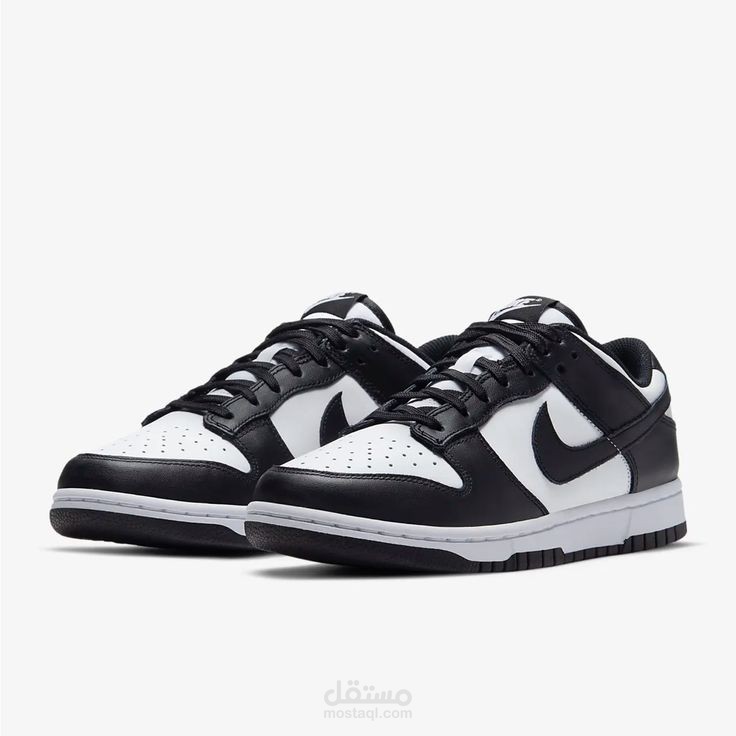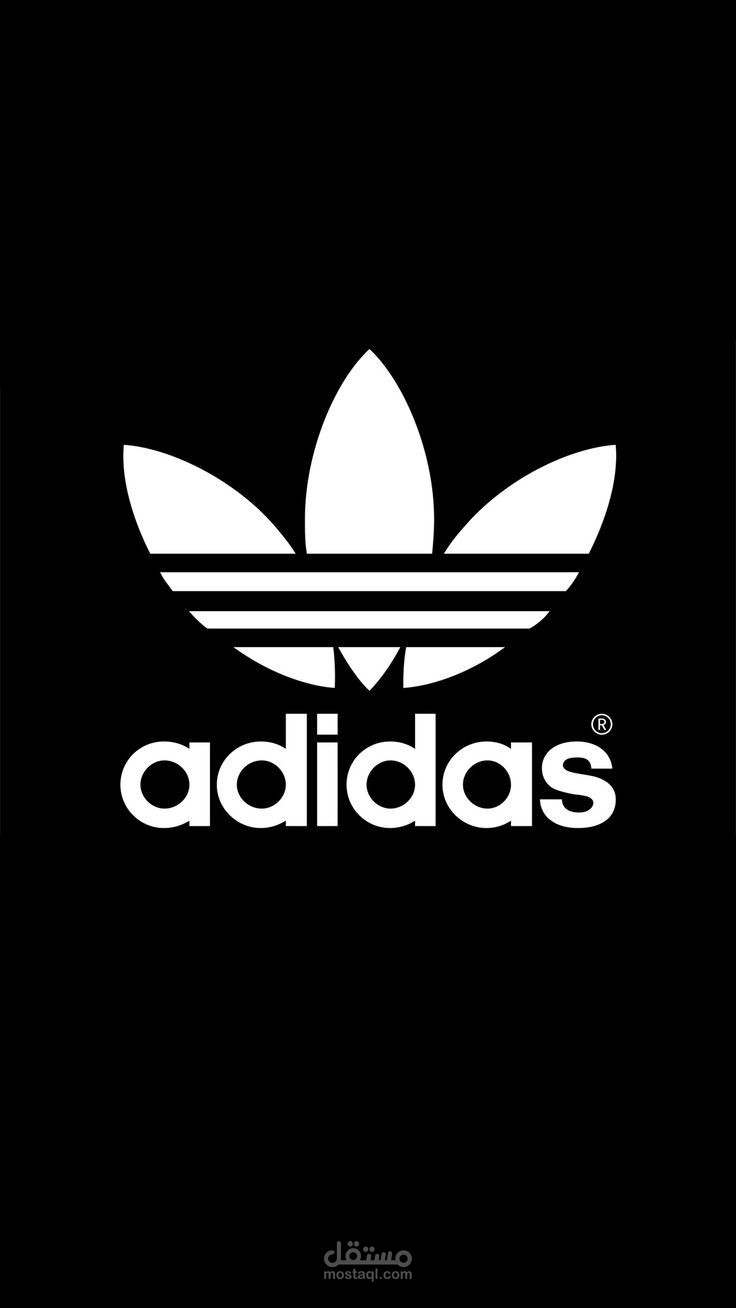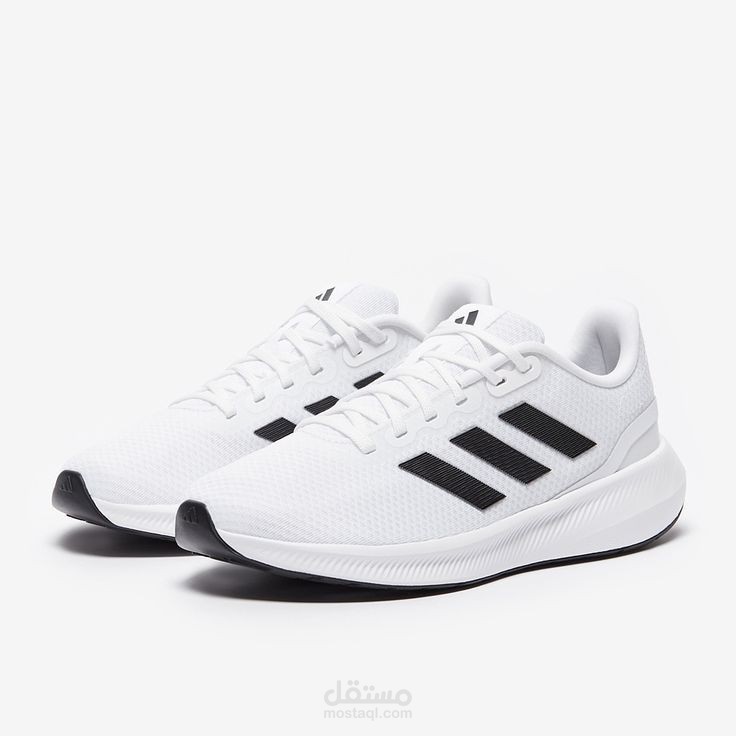Comparison between Nike and Adidas
تفاصيل العمل
Nike and Adidas are two of the biggest names in the global sportswear market, each with distinct brand identities, strengths, and strategies. Here's a comparison between the two:
1. Brand Origin and History:
Nike: Founded in 1964 by Bill Bowerman and Phil Knight as "Blue Ribbon Sports," it became Nike in 1971. The brand's logo, the Swoosh, symbolizes movement and speed. Nike focuses heavily on innovation and technology.
Adidas: Established in 1949 by Adolf "Adi" Dassler in Germany, Adidas is known for its iconic three-stripe logo. It has a deep history in both performance and lifestyle sportswear.
2. Market Focus:
Nike: Primarily focused on athletic performance, it appeals to athletes across various sports, including basketball, running, soccer, and tennis. Nike is known for its technological advancements, such as the Air Max cushioning system and Nike Flyknit.
Adidas: While Adidas also focuses on performance gear, it has a strong presence in both performance sports and lifestyle fashion. The brand is known for its collaborations with artists and designers (e.g., Kanye West's Yeezy collection) and its iconic Originals line.
3. Innovation and Technology:
Nike: Known for cutting-edge technology in footwear, including the Nike Air cushioning, Flyknit uppers, and React foam. Nike has also embraced digital innovation through platforms like the Nike Training Club app and the Nike Adapt self-lacing shoes.
Adidas: Known for innovations like Boost cushioning (in collaboration with BASF), Primeknit, and the Futurecraft 3D-printed shoes. Adidas also emphasizes sustainability, with initiatives like the Parley for the Oceans collection and shoes made from recyclable materials.
4. Sports Sponsorships and Endorsements:
Nike: Has high-profile athlete endorsements, including basketball legend Michael Jordan (with the Jordan brand), LeBron James, Serena Williams, and Cristiano Ronaldo. Nike’s athlete-centric marketing is a big part of its global presence.
Adidas: Sponsors athletes like Lionel Messi, James Harden, and Novak Djokovic, and has deep connections with soccer, including being the official supplier for FIFA and several top soccer clubs.
5. Cultural Influence:
Nike: Nike has positioned itself as a symbol of empowerment, particularly through campaigns like "Just Do It" and its advocacy for athletes and social causes. It has a strong influence on global streetwear culture, especially with limited-edition sneaker releases.
Adidas: Known for merging sport and fashion, Adidas has a notable presence in the streetwear scene, especially with its collaborations with Kanye West (Yeezy) and Pharrell. The brand’s focus on design and innovation appeals to both athletes and fashion-conscious individuals.
6. Sustainability:
Nike: While Nike has made efforts toward sustainability, including using recycled materials in some of its products and setting goals for reducing carbon emissions, critics argue it still has a long way to go.
Adidas: Often seen as a leader in sustainability in the sportswear industry, Adidas has invested heavily in using sustainable materials, like the Parley shoes made from ocean plastic. They aim to create products with a more minimal environmental impact.
7. Global Reach:
Nike: Nike is a global powerhouse, with a strong presence in North America, Europe, and Asia. It has become synonymous with sports and is often seen as a more dominant player in the performance segment.
Adidas: Adidas, while also global, has a particularly strong foothold in Europe, particularly in soccer (football). It has been growing in North America and Asia, bolstered by its fashion collaborations.
8. Pricing and Product Range:
Nike: Offers a wide range of products from high-performance athletic gear to casual lifestyle wear. Nike’s premium products, like the Air Jordans and limited-edition shoes, can command high prices.
Adidas: Offers a similar range but is often perceived as slightly more affordable on average. However, Adidas' collaborations (like Yeezy) can push the price point higher.
9. Retail Strategy:
Nike: Strong focus on direct-to-consumer sales through its own retail stores, Nike.com, and the Nike app. The brand has a larger presence in direct-to-consumer channels compared to Adidas.
Adidas: Similarly, Adidas focuses on online sales and branded stores but also relies heavily on partnerships with retailers like Foot Locker. The brand has been expanding its e-commerce reach.
Conclusion:
Both Nike and Adidas are dominant forces in the sportswear industry, but they have carved out unique niches. Nike is often seen as the leader in innovation, performance, and athlete endorsements, while Adidas shines in style, culture, and sustainability. Consumers may choose based on their specific needs—whether it’s advanced performance gear, lifestyle streetwear, or a combination of both.
باللغه العربيه
تعد Nike وAdidas من أكبر الأسماء في سوق الملابس الرياضية العالمية، ولكل منهما هوية علامة تجارية مميزة ونقاط قوة واستراتيجيات. فيما يلي مقارنة بين الاثنين: 1. أصل العلامة التجارية وتاريخها: Nike: تأسست عام 1964 على يد بيل باورمان وفيل نايت باسم "Blue Ribbon Sports"، ثم أصبحت Nike في عام 1971. شعار العلامة التجارية، Swoosh، يرمز إلى الحركة والسرعة. تركز Nike بشكل كبير على الابتكار والتكنولوجيا. أديداس: تأسست شركة أديداس عام 1949 على يد أدولف "عدي" داسلر في ألمانيا، وتشتهر بشعارها الشهير ذي الخطوط الثلاثة. لديها تاريخ عميق في كل من الملابس الرياضية ذات الأداء وأسلوب الحياة. 2. التركيز على السوق: Nike: تركز في المقام الأول على الأداء الرياضي، وهي تجذب الرياضيين في مختلف الألعاب الرياضية، بما في ذلك كرة السلة والجري وكرة القدم والتنس. تشتهر شركة Nike بتطوراتها التكنولوجية، مثل نظام توسيد Air Max وNike Flyknit. أديداس: بينما تركز أديداس أيضًا على معدات الأداء، إلا أنها تتمتع بحضور قوي في كل من الرياضات عالية الأداء وأزياء نمط الحياة. تشتهر العلامة التجارية بتعاونها مع الفنانين والمصممين (على سبيل المثال، مجموعة Yeezy من Kanye West) وخطها الأصلي الشهير. 3. الابتكار والتكنولوجيا: Nike: تشتهر بالتكنولوجيا المتطورة في الأحذية، بما في ذلك وسادة Nike Air والجزء العلوي من Flyknit ورغوة React. تبنت Nike أيضًا الابتكار الرقمي من خلال منصات مثل تطبيق Nike Training Club وأحذية Nike Adapt ذاتية الربط. Adidas: تشتهر بالابتكارات مثل وسادة Boost (بالتعاون مع BASF)، وPrimeknit، والأحذية المطبوعة بتقنية Futurecraft ثلاثية الأبعاد. تؤكد شركة Adidas أيضًا على الاستدامة، من خلال مبادرات مثل مجموعة Parley for the Oceans والأحذية المصنوعة من مواد قابلة لإعادة التدوير. 4. الرعاية والتأييدات الرياضية: Nike: لديها دعم رياضي رفيع المستوى، بما في ذلك أسطورة كرة السلة مايكل جوردان (مع العلامة التجارية Jordan)، وليبرون جيمس، وسيرينا ويليامز، وكريستيانو رونالدو. يعد التسويق الذي يركز على الرياضيين لشركة Nike جزءًا كبيرًا من تواجدها العالمي. أديداس: ترعى الرياضيين مثل ليونيل ميسي، وجيمس هاردن، ونوفاك ديوكوفيتش، ولها علاقات عميقة مع كرة القدم، بما في ذلك كونها المورد الرسمي للفيفا والعديد من أندية كرة القدم الكبرى. 5. التأثير الثقافي: نايكي: وضعت نايكي نفسها كرمز للتمكين، لا سيما من خلال حملات مثل "Just Do It" ودفاعها عن الرياضيين والقضايا الاجتماعية. ولها تأثير قوي على ثقافة أزياء الشارع العالمية، خاصة مع إصدارات الأحذية الرياضية ذات الإصدار المحدود. أديداس: تشتهر أديداس بدمج الرياضة والموضة، وتتمتع بحضور ملحوظ في مشهد أزياء الشارع، خاصة من خلال تعاونها مع كاني ويست (ييزي) وفاريل. إن تركيز العلامة التجارية على التصميم والابتكار يجذب كل من الرياضيين والأفراد المهتمين بالموضة. 6. الاستدامة: نايكي: في حين بذلت نايكي جهودًا لتحقيق الاستدامة، بما في ذلك استخدام المواد المعاد تدويرها في بعض منتجاتها ووضع أهداف للحد من انبعاثات الكربون، يقول النقاد إنه لا يزال أمامها طريق طويل لتقطعه. أديداس: غالبًا ما يُنظر إلى شركة أديداس على أنها رائدة في مجال الاستدامة في صناعة الملابس الرياضية، وقد استثمرت بكثافة في استخدام مواد مستدامة، مثل أحذية Parley المصنوعة من بلاستيك المحيط. إنهم يهدفون إلى إنشاء منتجات ذات تأثير بيئي أقل. 7. الوصول العالمي: Nike: تعتبر Nike شركة عالمية ذات حضور قوي في أمريكا الشمالية وأوروبا وآسيا. لقد أصبح مرادفًا للرياضة وغالبًا ما يُنظر إليه على أنه اللاعب الأكثر هيمنة في قطاع الأداء. أديداس: على الرغم من أن أديداس عالمية أيضًا، إلا أنها تتمتع بموطئ قدم قوي بشكل خاص في أوروبا، وخاصة في كرة القدم. لقد كانت تنمو في أمريكا الشمالية وآسيا، مدعومة بالتعاون في مجال الأزياء. 8. الأسعار ونطاق المنتجات: Nike: تقدم مجموعة واسعة من المنتجات بدءًا من المعدات الرياضية عالية الأداء وحتى الملابس غير الرسمية. يمكن أن تتطلب منتجات Nike المتميزة، مثل Air Jordans والأحذية ذات الإصدار المحدود، أسعارًا مرتفعة. أديداس: تقدم مجموعة مماثلة ولكن غالبًا ما يُنظر إليها على أنها أقل تكلفة قليلاً في المتوسط. ومع ذلك، فإن تعاونات Adidas (مثل Yeezy) يمكن أن تدفع نقطة السعر إلى الأعلى. 9. استراتيجية البيع بالتجزئة: Nike: تركيز قوي على المبيعات المباشرة للمستهلك من خلال متاجر البيع بالتجزئة الخاصة بها، Nike.com، وتطبيق Nike. تتمتع العلامة التجارية بحضور أكبر في القنوات المباشرة للمستهلك مقارنة بشركة Adidas. أديداس: بالمثل، تركز أديداس على المبيعات عبر الإنترنت والمتاجر ذات العلامات التجارية ولكنها تعتمد أيضًا بشكل كبير على الشراكات مع تجار التجزئة مثل فوت لوكر. تعمل العلامة التجارية على توسيع نطاق التجارة الإلكترونية. الخلاصة: تعد كل من نايكي وأديداس من القوى المهيمنة في صناعة الملابس الرياضية، لكنهما ابتكرتا مجالات فريدة من نوعها. غالبًا ما يُنظر إلى نايكي على أنها الشركة الرائدة في مجال الابتكار والأداء والتأييد الرياضي، بينما تتألق أديداس في الأسلوب والثقافة والاستدامة. يمكن للمستهلكين الاختيار بناءً على احتياجاتهم الخاصة، سواء كانت معدات الأداء المتقدمة، أو ملابس الشارع العصرية، أو مزيجًا من الاثنين معًا.
